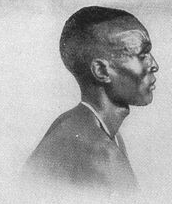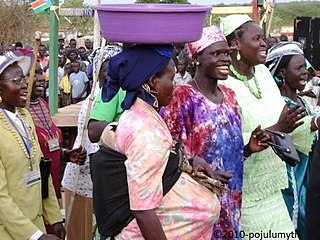Related Research Articles
The Nilotic peoples are people indigenous to the Nile Valley who speak Nilotic languages. They inhabit South Sudan, Sudan, Ethiopia, Uganda, Kenya, the Democratic Republic of the Congo, Rwanda, Burundi and Tanzania. Among these are the Burun-speaking peoples, Karo peoples, Luo peoples, Ateker peoples, Kalenjin peoples, Datooga, Dinka, Nuer, Atwot, Lotuko, and the Maa-speaking peoples.
Dinka spirituality refers to the traditional religion of the Dinka people, an ethnic group of South Sudan. They belong to the Nilotic peoples, which is a group of cultures in Southern Sudan and wider Eastern Africa. The Dinka people largely rejected or ignored Islamic teachings, as Abrahamic religious beliefs were incompatible with their society, culture and traditional beliefs.
Francis Piol Bol Bok, a Dinka tribesman and native of South Sudan, was a slave for ten years but became an abolitionist and author living in the United States. On May 15, 1986, he was captured and enslaved at the age of seven during an Arab militia raid on the village of Nyamlel in South Sudan during the Second Sudanese Civil War. Bok lived in bondage for ten years before escaping imprisonment in Kurdufan, Sudan, followed by a journey to the United States by way of Cairo, Egypt.

The Dinka tribe are a Nilotic ethnic group native to South Sudan with a sizable diaspora population abroad. The Dinka mostly live along the Nile, from Jonglei to Renk, in the region of Bahr el Ghazal, Upper Nile, and the Abyei Area of the Ngok Dinka in South Sudan.

The Nuer people are a Nilotic ethnic group concentrated in the Greater Upper Nile region of South Sudan. They also live in the Ethiopian region of Gambella. The Nuer speak the Nuer language, which belongs to the Nilotic language family. They are the second largest ethnic group in South Sudan. The Nuer people are pastoralists who herd cattle for a living. Their cattle serve as companions and define their lifestyle. The Nuer call themselves "Naath".

The Shilluk are a major Luo Nilotic ethnic group of Southern Sudan, living on both banks of the river Nile, in the vicinity of the city of Malakal. Before the Second Sudanese Civil War the Shilluk also lived in a number of settlements on the northern bank of the Sobat River, close to where the Sobat joins the Nile.
Garang is a common name used by the Dinka people of South Sudan. The name has different definitions among the Dinka people i.e. the Bor Community or Twic East Community. They refer it to the God of women. In Bahr el Ghazal the name can be defined as God, which may be refer to Garang Abuk. Garang may refer to:
Dinka is a Nilotic dialect cluster spoken by the Dinka people, the major ethnic group of South Sudan. There are several main varieties, Padang, Rek, Agaar, Bor, Hol, Twic East, Twic, which are distinct enough to require separate literary standards. Jaang, Jieng or Monyjieng is used as a general term to cover all Dinka languages. Recently Akutmɛ̈t Latueŋ Thuɔŋjäŋ has proposed a unified written grammar of Dinka.
The Murle are a Surmic ethnic group inhabiting the Pibor County and Boma area in Greater Pibor Administrative area, South Sudan, as well as parts of southwestern Ethiopia. They have also been referred as Beir by the Dinka and as Jebe by the Luo and Nuer, among others. The Murle speak the Murle language, which is part of the Surmic language family. The language cluster includes some adjoining groups in Sudan, as well as some non-contiguous Surmic populations in southwestern Ethiopia.
Deng, also known as Denka, is a sky, rain, and fertility god in Dinka mythology for the Dinka people of Sudan and South Sudan. He is the son of the goddess Abuk.

The Pojulu tribe is of the savanna lands in the White Nile Valley, in the Equatoria region of South Sudan. They are Nilotic people and part of the Karo people — which also includes Bari, Mundari, Kakwa, Kuku, Nyangwara, and [[The Karo Tribes Of Omo Valley in Ethiopia such as the ,Banna, Hamer, Mursi, Kara, Dassanech, Arbore, Nyangatom known as the Omo Karo peoples.
The Atwot (Reel) are a Nilotic ethnic group of South Sudan who live near Yirol in Eastern Lakes State. They comprise a majority of the population in the payam of Yirol West.
Archdeacon Archibald Shaw was a pioneer missionary amongst the Dinka people with the Gordon Memorial Sudan Mission of the Church Missionary Society (CMS) in southern Sudan in the first half of the 20th century.

South Sudan is home to around 60 indigenous ethnic groups and 80 linguistic partitions among a 2021 population of around 11 million. Historically, most ethnic groups were lacking in formal Western political institutions, with land held by the community and elders acting as problem solvers and adjudicators. Today, most ethnic groups still embrace a cattle culture in which livestock is the main measure of wealth and used for bride wealth.
Vincent Reynolds Woodland was a British colonial administrator who was governor of Mongalla Province of the southern Anglo-Egyptian Sudan from 1920 to 1924.

The Catholic Church in South Sudan is composed of one ecclesiastical province with one archdiocese and six suffragan dioceses. There have been a total of 31 bishops in South Sudan to date. The bishops of South Sudan and Sudan are currently members of one single bishops' conference, designated as Sudan Catholic Bishops’ Conference.

The Dinka–Nuer West Bank Peace & Reconciliation Conference of 1999 was held in what was then the Southern part of Sudan. It is commonly called the "Wunlit Peace Conference" after Wunlit, the village where it was held in eastern Tonj County in Bahr El Ghazal. The conference brought together Nuer from Western Upper Nile and Dinka from Tonj, Rumbek, and Yirol. It is the most prominent and comprehensively documented case of a people-to-people peace process in what is now the Republic of South Sudan.
Nhialic is the supreme creator god of the Dinka pantheon, whose people now dwell in South Sudan. When used in the context of Dinka language, the term also can refer to the entirety of the gods within the Dinka pantheon. In some accounts, Nhialic is also known as Deng Dit.
Kejok is a mythic hero figure in the traditional religion of the Dinka people, who dwells in present-day Sudan.
Mathiang Yak Anek was a 19th-century female Dinka chief and escaped slave. Born in the 1860s, she was enslaved as a child by Turkish-Egyptian traders. She escaped during the advance of British colonial troops and returned to her home in Pathiong Gok. She became the chief of her people. Following a dispute with a rival leader, she was removed from her position by colonial officials.
References
- ↑ Beswick, Stephanie (2004). Sudan's Blood Memory: The Legacy of War, Ethnicity, and Slavery in South Sudan. Boydell & Brewer. p. 128. ISBN 1-58046-151-4.
- 1 2 3 Monaghan, Patricia (1 April 2014). Encyclopedia of Goddesses and Heroines (revised ed.). New World Library. ISBN 978-1608682188 . Retrieved 2015-05-17.
- ↑ Lienhardt, Godfrey (1987). Divinity and Experience: The Religion of the Dinka. Oxford University Press. p. 89. ISBN 0-19-823405-8.